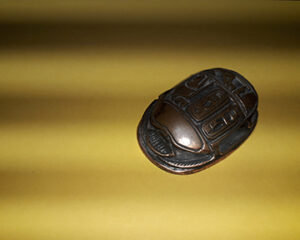When the tomb of King Tut was discovered in 1922, it ignited a worldwide craze for Egyptian Revival Jewelry. The discovery, along with the translation of the Rosetta Stone in 1822 and the opening of the Suez Canal in 1869, helped bring Egyptomania to a fever pitch in the West. But this interest in ancient civilizations dates back much further than these events, originating with the French Revolution and Napoleon’s campaign in Egypt. During his time in Egypt, the French monarch studied archaeology as a science and made many

discoveries. When he returned to France, he brought home a treasure trove of inspiration. Napoleon continued to pursue an interest in Egypt and its ancient history.
This interest in Egypt spread to Europe and influenced not only the design of a wide range of products, but also the way we see and think about architecture, music, and art. It even permeated the fashion industry. Jewelry became a popular form of expression that reflected an individual’s interest in Egypt’s ancient culture. A lotus flower was often depicted in jewelry, with its symbolic association with the Sun god Aman-Ra. The ankh, a hieroglyph for life, was also an important motif in Egyptian jewelry. The Ba, a bird-like aspect of the ‘soul’ that could travel out of the tomb after death, was another key symbol in Egyptian culture. These motifs were used in many styles of jewelry, from heavy gold shield shaped brooches and earrings of the Victorian period to the more refined ‘Art Deco’ pieces that are still in vogue today.
Cloisonné enamel was also very popular among jewelers and was frequently used in the depiction of Egyptian motifs. The motifs, including ram’s head and scarab beetles, were also often carved in precious and semiprecious gemstones, for example, sapphire and lapis lazuli, which the ancients believed would protect the wearer from evil. In the late 19th century, when the craze for Egyptian motifs reached its peak, jewelers were not attempting to recreate ancient Egyptian motifs as accurately as they had done in the past, but rather to adapt them to a modern style. The Egyptian Revival movement was an apt name for this refined mash-up of two different eras and a fusion of artistic technique.

In the early 20th century, the art deco movement became more prevalent, but Egyptian motifs remained popular and were particularly favored by French jewelers like Cartier, who were the most prolific purveyors of Egyptian-inspired jewelry. They incorporated the motifs of ancient Egypt into their creations by studying the popular source books for design inspiration, including Description de l’Egypte and The Grammar of Ornament. While the majority of their work was cloisonné, they also produced Egyptian inspired jewelry in metals such as, gold, platinum, silver and precious stones such as diamond, sapphire, and emerald. This refined combination of modern techniques with a theme that had been around for thousands of years, continues to be incredibly popular and is highly coveted by the modern collector.
